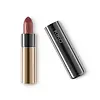KIKO Milano Gossamer Emotion Creamy Lipstick Versus NYX Cosmetics Lip Lingerie XXL Long-Lasting Matte Liquid Lipstick
What's inside
What's inside
 Key Ingredients
Key Ingredients

No key ingredients
 Benefits
Benefits

No benefits
 Concerns
Concerns

 Ingredients Side-by-side
Ingredients Side-by-side

Di-C12-13 Alkyl Tartrate
EmollientOctyldodecanol
EmollientMyristyl Trisiloxane
EmollientCetyl Dimethicone
EmollientPolyethylene
AbrasiveCaprylic/Capric Triglyceride
MaskingCera Microcristallina
Emulsion StabilisingC30-45 Alkyl Dimethicone
Skin ConditioningMica
Cosmetic ColorantTalc
AbrasiveStearalkonium Bentonite
Gel FormingDicalcium Phosphate
AbrasivePropylene Carbonate
SolventSynthetic Fluorphlogopite
Ethyl Vanillin
MaskingCaprylyl Methicone
Skin ConditioningZea Mays Oil
EmulsifyingEthylhexyl Palmitate
EmollientPhalaenopsis Amabilis Extract
HumectantPentaerythrityl Tetra-Di-T-Butyl Hydroxyhydrocinnamate
AntioxidantTrihydroxystearin
Skin ConditioningCentella Asiatica Extract
CleansingSodium Hyaluronate
HumectantGlucomannan
Skin ConditioningTocopheryl Acetate
AntioxidantBHT
AntioxidantTin Oxide
AbrasiveCI 77891
Cosmetic ColorantCI 77491
Cosmetic ColorantCI 77947
CI 75470
Cosmetic ColorantCI 15850
Cosmetic ColorantCI 42090
Cosmetic ColorantCI 45380
Cosmetic ColorantCI 45410
Cosmetic ColorantDi-C12-13 Alkyl Tartrate, Octyldodecanol, Myristyl Trisiloxane, Cetyl Dimethicone, Polyethylene, Caprylic/Capric Triglyceride, Cera Microcristallina, C30-45 Alkyl Dimethicone, Mica, Talc, Stearalkonium Bentonite, Dicalcium Phosphate, Propylene Carbonate, Synthetic Fluorphlogopite, Ethyl Vanillin, Caprylyl Methicone, Zea Mays Oil, Ethylhexyl Palmitate, Phalaenopsis Amabilis Extract, Pentaerythrityl Tetra-Di-T-Butyl Hydroxyhydrocinnamate, Trihydroxystearin, Centella Asiatica Extract, Sodium Hyaluronate, Glucomannan, Tocopheryl Acetate, BHT, Tin Oxide, CI 77891, CI 77491, CI 77947, CI 75470, CI 15850, CI 42090, CI 45380, CI 45410
Dimethicone
EmollientIsododecane
EmollientTrimethylsiloxysilicate
EmollientNylon-611/Dimethicone Copolymer
Skin ConditioningDimethicone Crosspolymer
Emulsion StabilisingC30-45 Alkyldimethylsilyl Polypropylsilsesquioxane
Lauroyl Lysine
Skin ConditioningTriethoxysilylethyl Polydimethylsiloxyethyl Dimethicone
Skin ConditioningSilica Silylate
EmollientIsopropyl Titanium Triisostearate
EmollientSorbic Acid
PreservativePhenoxyethanol
PreservativeParfum
MaskingCI 15850
Cosmetic ColorantCI 45410
Cosmetic ColorantCI 77491
Cosmetic ColorantCI 77492
Cosmetic ColorantCI 77499
Cosmetic ColorantCI 77891
Cosmetic ColorantCI 19140
Cosmetic ColorantCI 42090
Cosmetic ColorantDimethicone, Isododecane, Trimethylsiloxysilicate, Nylon-611/Dimethicone Copolymer, Dimethicone Crosspolymer, C30-45 Alkyldimethylsilyl Polypropylsilsesquioxane, Lauroyl Lysine, Triethoxysilylethyl Polydimethylsiloxyethyl Dimethicone, Silica Silylate, Isopropyl Titanium Triisostearate, Sorbic Acid, Phenoxyethanol, Parfum, CI 15850, CI 45410, CI 77491, CI 77492, CI 77499, CI 77891, CI 19140, CI 42090
Ingredients Explained
These ingredients are found in both products.
Ingredients higher up in an ingredient list are typically present in a larger amount.
Ci 15850 is the pigment color red. It is an azo dye and created synthetically.
Azo dyes need to be thoroughly purified before use. This allows them to be more stable and longer-lasting.
This ingredient is common in foundations, lipsticks, and blushes. This color is described as brown/orangey red.
It has many secondary names such as Red 6 and Red 7. According to a manufacturer, Red 6 usually contains aluminum.
Learn more about CI 15850Ci 42090 is a synthetic dye created from petroleum. It is used to give a bright blue color to cosmetics, medicine, and food.
CI 45410 is a synthetic red-pigment and dye.
It often goes by both Red 28 or Red 27; manufacturers label both ingredients as CI 45410.
This dye is commonly found in makeup because it imparts a vivid color. Some types of this dye change color based on pH level and interaction with moisture:
Your skin has a natural pH of around 4.5 - 5.5.
According to the FDA, CI 45410 is not permitted for use in eye products.
Red 27 is a flourescein dye and commonly used as a fluorescent tracer in medicine.
Learn more about CI 45410Ci 77491 is also hydrated iron III oxide. It's sole purpose is to give a red/pink hue to products.
Iron III oxides are classified as inorganic chemicals for coloring.
Synthetically created Ci 77491 is considered safer than those naturally found. This is because the synthetically created version may contain less impurities. Iron oxides are generally non-toxic and non-allergenic.
Learn more about CI 77491Ci 77891 is a white pigment from Titanium dioxide. It is naturally found in minerals such as rutile and ilmenite.
It's main function is to add a white color to cosmetics. It can also be mixed with other colors to create different shades.
Ci 77891 is commonly found in sunscreens due to its ability to block UV rays.
Learn more about CI 77891